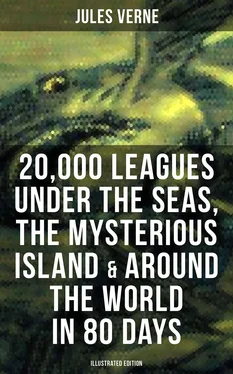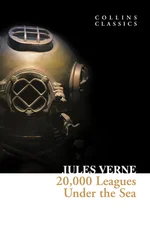“And that locality is … ?” I asked.
“That locality lies a little above Suez in a sound that used to form a deep estuary when the Red Sea stretched as far as the Bitter Lakes. Now, whether or not their crossing was literally miraculous, the Israelites did cross there in returning to the Promised Land, and the Pharaoh’s army did perish at precisely that locality. So I think that excavating those sands would bring to light a great many weapons and tools of Egyptian origin.”
“Obviously,” I replied. “And for the sake of archaeology, let’s hope that sooner or later such excavations do take place, once new towns are settled on the isthmus after the Suez Canal has been cut through— a canal, by the way, of little use to a ship such as the Nautilus!”
“Surely, but of great use to the world at large,” Captain Nemo said. “The ancients well understood the usefulness to commerce of connecting the Red Sea with the Mediterranean, but they never dreamed of cutting a canal between the two, and instead they picked the Nile as their link. If we can trust tradition, it was probably Egypt’s King Sesostris who started digging the canal needed to join the Nile with the Red Sea. What’s certain is that in 615 B.C. King Necho II was hard at work on a canal that was fed by Nile water and ran through the Egyptian plains opposite Arabia. This canal could be traveled in four days, and it was so wide, two triple-tiered galleys could pass through it abreast. Its construction was continued by Darius the Great, son of Hystaspes, and probably completed by King Ptolemy II. Strabo saw it used for shipping; but the weakness of its slope between its starting point, near Bubastis, and the Red Sea left it navigable only a few months out of the year. This canal served commerce until the century of Rome’s Antonine emperors; it was then abandoned and covered with sand, subsequently reinstated by Arabia’s Caliph Omar I, and finally filled in for good in 761 or 762 A.D. by Caliph Al-Mansur, in an effort to prevent supplies from reaching Mohammed ibn Abdullah, who had rebelled against him. During his Egyptian campaign, your General Napoleon Bonaparte discovered traces of this old canal in the Suez desert, and when the tide caught him by surprise, he wellnigh perished just a few hours before rejoining his regiment at Hadjaroth, the very place where Moses had pitched camp 3,300 years before him.”
“Well, captain, what the ancients hesitated to undertake, Mr. de Lesseps is now finishing up; his joining of these two seas will shorten the route from Cadiz to the East Indies by 9,000 kilometers, and he’ll soon change Africa into an immense island.”
“Yes, Professor Aronnax, and you have every right to be proud of your fellow countryman. Such a man brings a nation more honor than the greatest commanders! Like so many others, he began with difficulties and setbacks, but he triumphed because he has the volunteer spirit. And it’s sad to think that this deed, which should have been an international deed, which would have insured that any administration went down in history, will succeed only through the efforts of one man. So all hail to Mr. de Lesseps!”
“Yes, all hail to that great French citizen,” I replied, quite startled by how emphatically Captain Nemo had just spoken.
“Unfortunately,” he went on, “I can’t take you through that Suez Canal, but the day after tomorrow, you’ll be able to see the long jetties of Port Said when we’re in the Mediterranean.”
“In the Mediterranean!” I exclaimed.
“Yes, professor. Does that amaze you?”
“What amazes me is thinking we’ll be there the day after tomorrow.”
“Oh really?”
“Yes, captain, although since I’ve been aboard your vessel, I should have formed the habit of not being amazed by anything!”
“But what is it that startles you?”
“The thought of how hideously fast the Nautilus will need to go, if it’s to double the Cape of Good Hope, circle around Africa, and lie in the open Mediterranean by the day after tomorrow.”
“And who says it will circle Africa, professor? What’s this talk about doubling the Cape of Good Hope?”
“But unless the Nautilus navigates on dry land and crosses over the isthmus—”
“Or under it, Professor Aronnax.”
“Under it?”
“Surely,” Captain Nemo replied serenely. “Under that tongue of land, nature long ago made what man today is making on its surface.”
“What! There’s a passageway?”
“Yes, an underground passageway that I’ve named the Arabian Tunnel. It starts below Suez and leads to the Bay of Pelusium.”
“But isn’t that isthmus only composed of quicksand?”
“To a certain depth. But at merely fifty meters, one encounters a firm foundation of rock.”
“And it’s by luck that you discovered this passageway?” I asked, more and more startled.
“Luck plus logic, professor, and logic even more than luck.”
“Captain, I hear you, but I can’t believe my ears.”
“Oh, sir! The old saying still holds good: Aures habent et non audient!* Not only does this passageway exist, but I’ve taken advantage of it on several occasions. Without it, I wouldn’t have ventured today into such a blind alley as the Red Sea.”
*Latin: “They have ears but hear not.” Ed.
“Is it indiscreet to ask how you discovered this tunnel?”
“Sir,” the captain answered me, “there can be no secrets between men who will never leave each other.”
I ignored this innuendo and waited for Captain Nemo’s explanation.
“Professor,” he told me, “the simple logic of the naturalist led me to discover this passageway, and I alone am familiar with it. I’d noted that in the Red Sea and the Mediterranean there exist a number of absolutely identical species of fish: eels, butterfish, greenfish, bass, jewelfish, flying fish. Certain of this fact, I wondered if there weren’t a connection between the two seas. If there were, its underground current had to go from the Red Sea to the Mediterranean simply because of their difference in level. So I caught a large number of fish in the vicinity of Suez. I slipped copper rings around their tails and tossed them back into the sea. A few months later off the coast of Syria, I recaptured a few specimens of my fish, adorned with their telltale rings. So this proved to me that some connection existed between the two seas. I searched for it with my Nautilus, I discovered it, I ventured into it; and soon, professor, you also will have cleared my Arabic tunnel!”
Table of Contents
THE SAME DAY, I reported to Conseil and Ned Land that part of the foregoing conversation directly concerning them. When I told them we would be lying in Mediterranean waters within two days, Conseil clapped his hands, but the Canadian shrugged his shoulders.
“An underwater tunnel!” he exclaimed. “A connection between two seas! Who ever heard of such malarkey!”
“Ned my friend,” Conseil replied, “had you ever heard of the Nautilus? No, yet here it is! So don’t shrug your shoulders so blithely, and don’t discount something with the feeble excuse that you’ve never heard of it.”
“We’ll soon see!” Ned Land shot back, shaking his head. “After all, I’d like nothing better than to believe in your captain’s little passageway, and may Heaven grant it really does take us to the Mediterranean.”
The same evening, at latitude 21 degrees 30’ north, the Nautilus was afloat on the surface of the sea and drawing nearer to the Arab coast. I spotted Jidda, an important financial center for Egypt, Syria, Turkey, and the East Indies. I could distinguish with reasonable clarity the overall effect of its buildings, the ships made fast along its wharves, and those bigger vessels whose draft of water required them to drop anchor at the port’s offshore mooring. The sun, fairly low on the horizon, struck full force on the houses in this town, accenting their whiteness. Outside the city limits, some wood or reed huts indicated the quarter where the bedouins lived.
Читать дальше












